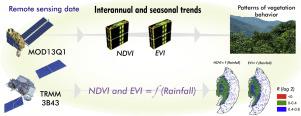Ecological Engineering ( IF 3.9 ) Pub Date : 2021-02-11 , DOI: 10.1016/j.ecoleng.2021.106180 Rosane Gomes da Silva , Alexandre Rosa dos Santos , João Batista Esteves Pelúzio , Nilton César Fiedler , Ronie Silva Juvanhol , Kaíse Barbosa de Souza , Elvis Ricardo Figueira Branco

|
Among worldwide tropical forest ecosystems, the Atlantic forest of Brazil stands out as a highly fragile area and a biodiversity hotspot, with a high degree of endemism. The Caparaó National Park is an important conservation area for this biome, where recent studies have found new species of animals and plants, including endemic and highly vulnerable ones. We analyzed interannual and seasonal trends in vegetation for Caparaó National Park and its buffer zone, using data from MODIS vegetation indices between the years 2001 and 2019. Our methods included both parametric (linear trend and linear correlation) and non-parametric (Mann-Kendall) analyses of interannual trends, wavelet transform, and seasonal trends analysis. We also studied the correlation of the vegetation index data with the variability of monthly rainfall data from the TRMM satellite. We generated linear regression analyses, with precipitation as the independent variable and Normalized Difference Vegetation Index (NDVI) and Enhanced Vegetation Index (EVI) as the dependent variable, and repeated this procedure for time lags from 0 to 3 months. In accordance with the findings of the temporal profiles and Mann Kendall trend method identified a prevalence of decreasing trend in the values of vegetation indices in Caparaó National Park, with values higher than 90% of the regions where the result was significant, for the EVI and 80% for the NDVI. For the buffer zone, there is an increasing trend for the NDVI and EVI, with values higher than 50% of the regions where the result was significant. In most of the area, a positive slope was found in the buffer zone, while in the Caparaó National Park the slope was predominantly negative. The r values indicated tendencies predominantly positive for the buffer zone and predominantly negative for the area within the park. 66.9% of the results were positive trends for ndvi in the buffer zone, and 51.7% for EVI, both for r value and slope. In the park area, this trend was negative in 68.9% of the area for ndvi in both methods; 93.8% for the EVI and 93.9% for the NDVI.
These differences may be evidence of how vegetation responds to disturbances, once the vegetation in the buffer zone is fragmented and does not have the same protection as vegetation in the park area. The native vegetation in study area shows seasonal similarities, as detected by seasonal trend analysis and wavelets transform. The existence of two annual cycles is a common feature to the biome of Atlantic forest. R values for the correlation of precipitation with vegetation indices indicate high dependence of vegetation on precipitation in the study area. Values in the 0.4 to 0.8 class, represented almost 80% of the buffer zone for the NDVI and 90% for the EVI. For Caparaó National Park, this class accounted for 27% and 38% of the area for the NDVI and EVI, respectively. Vegetation in the protected area was less dependent on rainfall, which can be attributed to the fact that it can better meet its water needs through available water in the soil. In addition, due to anthropogenic pressures and a high degree of forest fragmentation, vegetation in the buffer zone may have less advanced successional stages. Our results collaborate with the range of vegetation studies in the Brazilian Atlantic forest. This methodology can be applied to larger areas around the world to provide information on vegetation trends conditions and influence of climatic variables.
中文翻译:

巴西大西洋森林保护区的植被趋势
在世界范围的热带森林生态系统中,巴西的大西洋森林是一个高度脆弱的地区和一个生物多样性热点,具有高度的地方特有性。卡帕拉诺国家公园是这个生物群落的重要保护区,最近的研究发现新的动植物物种,包括地方性和高度脆弱的动植物。我们使用2001年至2019年间来自MODIS植被指数的数据分析了卡帕拉乌国家公园及其缓冲区的植被年际和季节趋势。我们的方法包括参数(线性趋势和线性相关)和非参数(Mann-Kendall) )的年际趋势分析,小波变换和季节性趋势分析。我们还研究了植被指数数据与TRMM卫星月降雨量数据变化之间的相关性。我们进行了线性回归分析,以降水量为自变量,归一化差异植被指数(NDVI)和增强植被指数(EVI)为因变量,并重复此过程进行了0到3个月的时滞。根据时间剖面的发现,Mann Kendall趋势方法确定了卡帕拉约国家公园植被指数值呈下降趋势的普遍性,对于EVI和EVI而言,该值高于结果显着区域的90%。 NDVI为80%。对于缓冲区,NDVI和EVI呈上升趋势,其值高于结果显着区域的50%。在该地区的大部分地区,在缓冲区中发现了一个正斜率,而在卡帕拉乌国家公园中,该斜率主要是负数。r值表示缓冲区的趋势主要为正,公园内区域的趋势主要为负。结果的66.9%是缓冲区中ndvi的正趋势,而rVI和r斜率是EVI的51.7%。在公园地区,两种方法在ndvi面积中的趋势均为68.9%呈负值;EVI为93.8%,NDVI为93.9%。
一旦缓冲区中的植被破碎并且与公园区域的植被没有相同的保护作用,这些差异可能是植被如何响应干扰的证据。通过季节趋势分析和小波变换检测,研究区的天然植被表现出季节相似性。存在两个年度循环是大西洋森林生物群系的共同特征。[R降水与植被指数的相关值表明研究区域植被对降水的高度依赖性。0.4到0.8的值代表NDVI的缓冲区的近80%,EVI的缓冲区的90%。对于卡帕拉乌国家公园,该类别分别占NDVI和EVI面积的27%和38%。保护区的植被较少依赖降雨,这可以归因于这样一个事实,即它可以通过土壤中的可用水更好地满足其水需求。此外,由于人为压力和高度的森林破碎化,缓冲区中的植被可能没有那么先进的演替阶段。我们的研究结果与巴西大西洋森林的一系列植被研究合作。











































 京公网安备 11010802027423号
京公网安备 11010802027423号